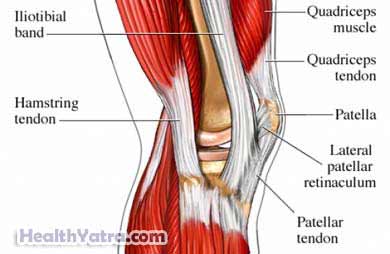Definition
Iliotibial band syndrome (ITBS) is an overuse injury. It happens in the soft tissues in the lower thigh, near the outside of the knee. The iliotibial band (ITB) is a thick band of fibrous tissue. It runs from the hip down the outside of the thigh and attaches to the tibia. The tibia is the large bone of the lower leg.
Treatment depends on the severity of the injury.

Causes
ITBS is caused by repetitive friction or rubbing of the iliotibial band against the bone on the outer side of the knee. This excessive rubbing can irritate the ITB itself and/or the tissue underneath.
Causes of the excessive friction include:
- Structural abnormalities, such as a short, tight IT band
- Problems related to the foot, ankle, or hip
- Opposing muscle imbalances, such as the quadriceps stronger than hamstrings
- A very prominent lateral femoral epicondyle, the bony structure on the outer side of the knee
- Inward rotation of the leg
- Angle where knee flexes
- Legs of different lengths
- Bowlegs
Risk Factors
Factors that increase your risk of getting ITBS include:
- Certain sports with repetitive motions, such as running and cycling
- Incorrect training technique
- Increasing distance run or cycling too quickly
- Running up and down hills
- Overtraining
- Using damaged or worn out equipment or footwear
- Wearing improper shoes for a sport or athletic activity
- Athletic equipment that is not properly fit to the user, such as a bicycle
Symptoms
Symptoms of ITBS include:
- Dull aching or burning sensation on the outside of the knee during or after activity
- Sharp stabbing pain on the outside of the knee during or after activity
- Pain that shows up in the hip, known as referred pain
- Progressive, worsening pain
- Snapping, creaking, or popping when the knee is bent and then straightened
Diagnosis
Your doctor will ask about your symptoms and medical history. In most cases, diagnosis can be made with a physical exam.
Tests may include:
- Obers test—determines the tightness of the ITB
- Rennes test—specifies the area of pain while full weight is placed on the bent leg
- Nobles test—determines the area of pain while the leg is flexed at a certain angle
For images of the internal structure of your leg, your doctor may recommend an MRI.
Treatment
Talk with your doctor about the best treatment plan for you. Recovery time ranges depending on the grade of your injury. Treatment steps may include:
Acute Care
Rest
Your IT band will need time to heal. Avoid activities that place extra stress on the knee:
- Do not do activities that cause pain. This includes running, jumping, and weight lifting using the leg muscles.
- If normal walking hurts, shorten your stride.
- Do not play sports until your doctor has said it is safe to do so.
Your doctor may recommend a foot orthotic to help control rototation of the foot. This will help stabilize the knee.
Cold
Apply an ice or a cold pack to the area for 15-20 minutes, four times a day, for several days after the injury. Do not apply the ice directly to your skin. Wrap the ice or cold pack in a towel.
Pain Relief Medications
To manage pain, your doctor may recommend:
- Over-the-counter medication, such as aspirin, ibuprofen, or acetaminophen
- Prescription pain relievers
- Corticosteroid injections
Recovery Steps
Heat
Use heat only when you are returning to physical activity. Heat may then be used before stretching or getting ready to play sports to help loosen the muscle.
Stretching
When the acute pain is gone, start gentle stretching as recommended. Stay within pain limits. Hold each stretch for about 10 seconds and repeat six times. Stretch several times a day.
Strengthening
Begin strengthening exercises for your muscles as recommended.
Surgery
Surgery may be necessary in cases when there is no response to other forms of treatment.
Prevention
To reduce your chances of ITBS, take these steps:
- Learning proper training techniques
- Increasing mileage run gradually
- Wearing appropriate shoes for each sport
- Replacing athletic shoes as they show signs of wear
- Being aware of running surfaces
- Using properly fitted equipment
- Strengthening quadriceps, hamstrings, and gluteal muscles
